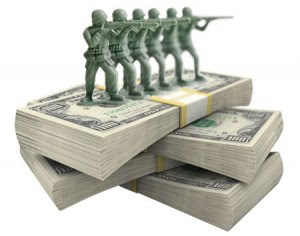
Why Is the US So Keen on Military Exercise?
Looking at the past two months, beginning on May 7 and lasting a few weeks, the United States, along with 19 other countries (12,000 people) held the “the largest naval exercises in the Middle East in the past ten years.” At the end of June, the U.S., Japan, and South Korea held a series of naval exercises in areas south of the Korean peninsula and Yellow Sea. Then, starting on June 29, the U.S. led a Pacific Rim naval exercise joined by 22 countries; this exercise will continue until Aug. 3.
Military exercise is undoubtedly one of the biggest money-burning “games” in the world right now. However, the United States, whose economic situation is not looking too good, is willing to invest lots of money and set off wave after wave of massive military exercises. Why is it so? What is the magic behind military exercise for the United States?
According to press reports, one of the keywords associated with military exercise is “showing muscle.” This directly points out one of the magical elements of naval exercise: to show-off armed force. In today’s world where peace is the main theme, large-scale warfare is unlikely to occur and naked aggressive war is also hard to maintain. Military exercise can mildly show the world one’s military strength, frighten one’s potential adversary or imaginary enemy, and further win over one’s allies. Using it as a backup, the United States, as a country with powerful military power, can naturally win the benefits it wants at the negotiating table.
Military exercise really burns money. Behind live ammunition exercise lies unimaginable amounts of money. Yet, at the sound of the guns, it’s not true that no one smiled. Yes, the arms dealers. No matter what country you’re in, arms dealers are forces that cannot be underestimated. After the baptism of World War II, the United States went through explosive growth and transformed from a negligible arms-exporting country to the world's number one arsenal. The arms chiefs of the United States have become objects that any session of the U.S. government dare not easily offend. Even in 2012, when the U.S. economy is in a downturn, U.S. military spending is still staggeringly high, totaling $690 billion. Moreover, the U.S. has been pursuing a “military Keynesian” theory for a long time. It believes that an increase in military spending can stimulate employment and economic growth. A “war economy” not only won’t weaken the strength of the U.S., it will make the U.S. stronger. The big net woven by many layers of interests has eliminated all doubts the U.S. may have had for the importance of military exercise in times of peace.
Military exercises have many other obvious effects. For example, they allow for tests on new weapons and equipment, as well as looks at new prospective arms buyers at the same time; they can train troops’ actual combat capability, and teach young soldiers to avoid scenarios where they have no place to vent their excess energy; they can, and do, eliminate social instability. Of course, to the Obama administration in a big election year, massive military exercises also bring benefits to the improvement of his support rate.
The United States is undoubtedly the strongest country in terms of military strength in the world. Why is the U.S. so keen to military exercise? The answer is not hard to find.
